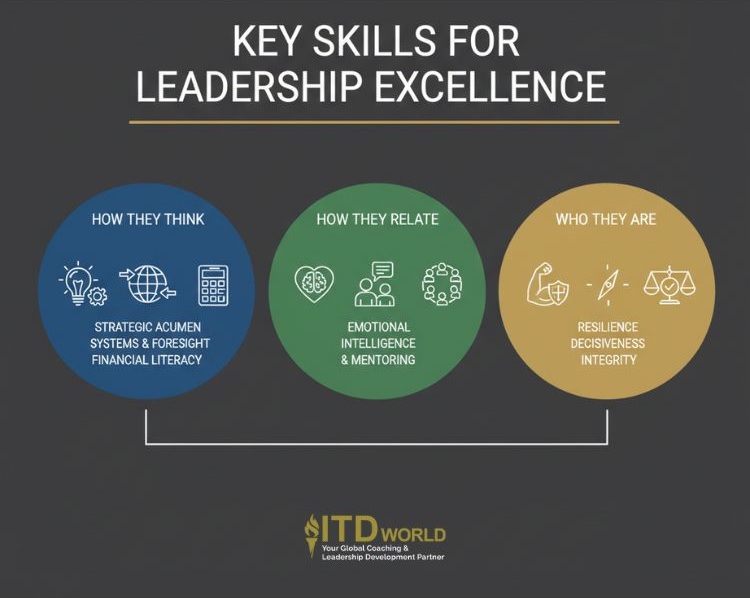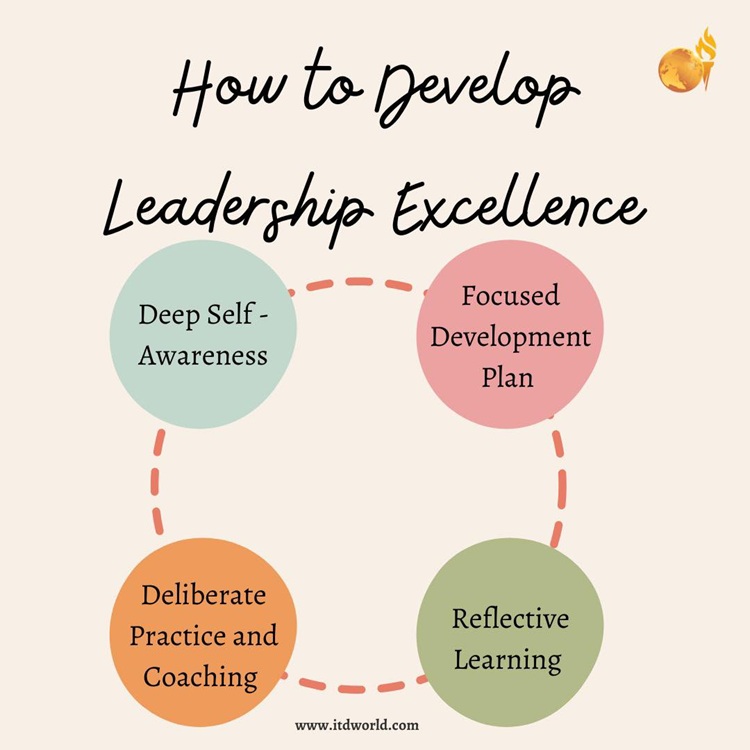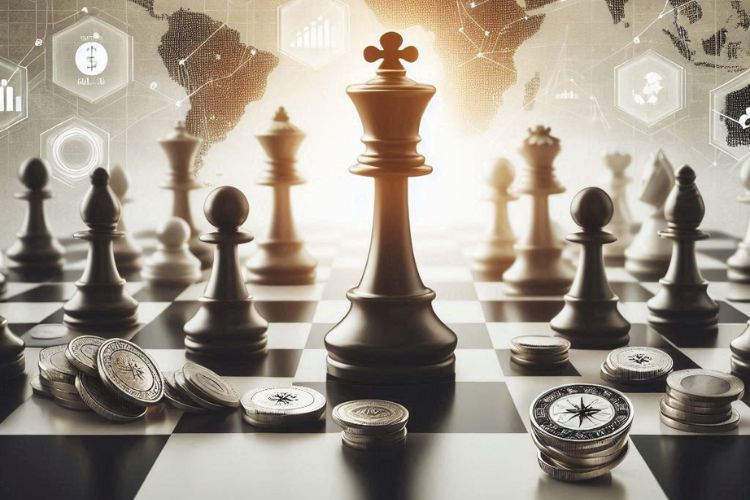Learn what leadership excellence looks like in action, its tangible ROI, the core competencies great leaders should possess, plus how organizations may foster them.
What separates companies that are merely successful from those that become legendary? The answer, as it turns out, is not found in their products or strategies alone – but in their unwavering commitment to leadership excellence. This is a standard that goes beyond just meeting targets; it is the consistent ability to inspire potential, drive innovation, and cultivate a resilient culture that thrives in any environment. Leadership excellence is not a soft skill – it is the ultimate competitive advantage and the most powerful engine for sustainable growth.
|
Author: Jonathan M. Pham |
Highlights
- Leadership excellence is the consistent ability to inspire and empower individuals and teams to achieve peak performance while cultivating a culture of innovation, trust, and purpose, going beyond mere competency to create a lasting legacy of growth.
- Cultivating excellence in leadership is a strategic imperative with a clear return on investment, as it directly correlates with superior financial performance, increased employee engagement and retention, enhanced innovation and agility, and a stronger brand reputation that attracts top talent, ultimately closing the costly “excellence gap” caused by poor leadership.
- Leadership excellence stems from a combination of honed competencies encompassing strategic acumen (how leaders think), human-centric leadership (how they relate to others), and personal fortitude (their core character), all of which are learnable skills rather than innate traits.
- Developing leadership excellence is a continuous journey that requires deep self-awareness, a focused development plan with specific goals and deliberate practice through stretch assignments, and consistent reflective learning, often supported by coaching and mentorship. From an organization perspective, they need to embed leadership competencies into all talent systems, invest in structured leadership development, foster psychological safety, and recognize and reward true efforts.
- Measuring excellence in leadership requires tracking both leading indicators like program engagement, quality of development plans, and succession pipeline strength – as well as lagging indicators such as employee engagement and retention, 360-degree feedback improvement, team and business unit performance, and innovation rates, to demonstrate ROI and drive continuous improvement.
What is Leadership Excellence?
In the business lexicon, “good” leadership is often associated with competency – meeting quarterly targets, managing teams effectively, and maintaining operational stability. While essential, it is merely the baseline.
At its core, leadership excellence is the consistent ability to inspire and empower individuals and teams to achieve peak performance while cultivating a culture of innovation, trust, and purpose. An excellent leader does not just direct resources; they develop people. They don’t just solve problems; they create possibilities. They are a multiplier of capability, leaving behind a legacy of growth that endures long after they are gone.
The concept can be broken down into three essential pillars:
- Visionary strategy: This refers to the ability to see beyond the immediate horizon, to synthesize complex information into a clear and compelling vision for the future. Leaders who excel in this area can articulate not just where the organization is going, but why it matters, energizing the entire workforce to move in a unified direction.
- Empathetic influence: A brilliant strategy is powerless without people to execute it. As such, leaders should demonstrate the capacity to connect with, understand, and motivate their teams on a human level. It involves building deep trust, communicating with authenticity, and inspiring commitment through influence, not just authority.
- Consistent execution: This is the pillar that transforms vision into reality. Excellence here means building resilient systems, fostering accountability, and developing the talent required to deliver on promises time and time again. It is the discipline that ensures a brilliant vision does not remain a daydream.

Let us think about how two different leaders might respond to a major market disruption. A good leader might react by focusing on control: cutting budgets, tightening processes, and managing the organization through the downturn. They might successfully steer the ship through the storm.
An excellent leader, however, sees the storm as an opportunity. They reframe the disruption as a catalyst for change, rallying their teams to find innovative solutions. They empower their people to experiment and pivot, ultimately using the crisis to capture new market share and build a more agile, resilient organization.
As you may see, the first one managed the present; the second created a better future. That is the true sign of leadership excellence.
The ROI of Leadership Excellence: Why It’s a Business Imperative
Pursuing leadership excellence is not a “nice-to-have” initiative focused on soft skills; it is a strategic necessity with a clear and compelling return on investment. In today’s competitive market, the quality of leadership is the single greatest predictor of organizational success. Organizations that intentionally cultivate excellence move beyond simply managing day-to-day operations to creating a true competitive advantage that shows up in their culture, their talent, and their bottom line.
The current state: The leadership excellence gap
The need for excellent leadership is highlighted by the staggering cost of its absence. Poor management practices don’t just create frustrating workdays; they create enormous economic drains.
According to Gallup’s research, low employee engagement, which is heavily influenced by managers, costs the global economy an estimated $8.8 trillion annually, or 9% of the global GDP. This “excellence gap” manifests in lost productivity, higher turnover, and a failure to innovate, representing a massive, often hidden, cost to businesses worldwide.
The tangible benefits of cultivating excellence
Organizations that successfully close this gap and invest in developing their executive leadership team reap significant and measurable rewards across all facets of their business:
- Superior financial performance: There is a direct correlation between the quality of leadership and financial health. McKinsey’s research consistently shows that organizations with top-quartile leadership outperform their peers, delivering three times the total shareholder returns compared to organizations with less effective leadership.
- Increased engagement & retention: It is well-documented that managers account for up to 70% of the variance in team engagement. Furthermore, a study by DDI found that effective leadership development can improve employee retention by as much as 12%, saving significant costs associated with recruitment and training.
- Enhanced innovation & agility: Leaders who foster psychological safety and empower their teams to experiment and learn from failure contribute to a culture where new ideas may flourish. The Harvard Business Review has noted that companies led by resilient and adaptable leaders are better equipped to navigate disruption and often emerge from challenges with higher profit margins than their peers.
- Stronger brand reputation & talent attraction: In today’s competitive talent market, an organization’s reputation for leadership is a key differentiator. A culture of excellence becomes a powerful magnet, attracting high-potential individuals who are actively seeking opportunities for growth, thereby creating a virtuous cycle of success.
Read more: Talent Acquisition – Strategies & Insights for Success

Key Skills for Leadership Excellence
Leadership excellence is not accidental; it is the direct result of a distinct combination of skills, mindsets, and personal attributes. These are not innate traits reserved for a select few, but rather a set of competencies that can be intentionally honed.
All in all, the core competencies may be grouped into three key domains: how a leader thinks, how they relate to others, and who they are at their core.
-
Strategic acumen (the “Thinking”)
Strategic acumen is the intellectual engine that drives an organization forward. It’s the ability to rise above daily complexities and navigate the business with a clear, long-term perspective.
- Systems thinking: The ability to see the organization as a complex, interconnected system. An excellent leader understands how a decision in finance may impact operations, how marketing initiatives affect sales, and how culture underpins everything, enabling them to make holistic and sustainable decisions.
- Strategic foresight: More than simple forecasting, it is the capacity to anticipate future trends, identify potential disruptions before they materialize, and position the organization proactively to seize emerging opportunities.
- Financial literacy: The skill to fluently speak the language of the business – demonstrated by a deep understanding of financial statements, key performance indicators, and the levers of profitability, allowing leaders to make sound, data-informed investment decisions.
-
Human-centric leadership (the “Relating”)
This domain covers the interpersonal skills that turn strategy into a shared mission. It’s the ability to build trust, inspire action, and unlock the potential of people.
- Emotional intelligence (EQ): The bedrock of influence, EQ involves the capacity to perceive, understand, and manage one’s own emotions while accurately sensing and influencing those of others. It enables leaders to build strong relationships, navigate difficult conversations, and foster deep loyalty.
- Coaching & mentoring mindset: Excellent leaders shift from being “directors” of work to “developers” of people. They possess a genuine commitment to growing their talent by asking powerful questions, listening actively, and empowering their team members to find solutions and own their success.
- Inclusive leadership: In other words, it is the active and intentional practice of creating an environment where every individual feels valued, respected, and heard. Inclusive leaders seek out diverse perspectives, mitigate bias, and ensure that the best ideas may rise from anywhere in the organization, leading to better decisions and innovation.
Read more: Love Leadership – More Than an Abstract Philosophical Idea
-
Personal fortitude (the “Being”)
This refers to the essential character of the leader – the inner strength and principles that guide their actions, especially under pressure.
- Resilience & adaptability: The capacity to absorb setbacks, learn from failure, and navigate ambiguity without losing momentum. Resilient leaders model stability and optimism, giving their teams the confidence to persevere through challenges.
- Decisiveness under pressure: In a world of incomplete information, excellent leaders have the courage and judgment to make tough, timely calls. They provide clarity and direction when it is needed most, preventing analysis paralysis and moving the organization forward.
- Unwavering integrity: The non-negotiable foundation of trust. It is a steadfast commitment to ethical principles, honesty, and transparency that earns the respect and confidence of all stakeholders, building a reputation that becomes a valuable asset for the entire organization.
Read more: Stakeholder Management – A Leader’s Engagement Playbook

How to Develop Leadership Excellence
Leadership excellence is not a title that is granted, nor is it a destination one arrives at. It is the outcome of a continuous and intentional process, undertaken by both the individual and the organization that supports them.
For any aspiring leader, the path to excellence is a cycle of deep self-reflection, deliberate action, and consistent learning.
-
Start with deep self-awareness
The journey begins with an honest assessment of one’s current impact – by moving beyond self-perception and gathering objective data through tools like 360-degree feedback, psychometric assessments, and candid conversations with trusted mentors. The goal is to clearly identify the gaps between one’s intent and how their leadership is actually experienced by others.
Read more: Intent vs Impact in the Workplace – How to Close the Gap
-
Create a focused development plan
Awareness must be translated into a concrete plan of action. Instead of setting vague goals, excellent leaders define specific, measurable objectives tied to the core competencies they need to develop.
Example: A vague goal is, “I want to be a better communicator.” A powerful development one is, “To enhance my Empathetic Influence, I will practice active listening techniques in my weekly one-on-one meetings. I will commit to summarizing my team member’s perspective before sharing my own, and I will ask for feedback on this specific skill from two colleagues at the end of each month.“
-
Seek deliberate practice and coaching
Skills are built through application, not just theory. In other words, one needs to actively seek out “stretch assignments” that push them beyond their comfort zone – i.e. leading a challenging project, managing a difficult change initiative, or working with a new team.
This journey is best traveled with a guide. An executive coach or mentor provides the objective perspective, accountability, and expert guidance needed to navigate challenges and accelerate growth.
-
Practice reflective learning
Experience alone is not the best teacher; evaluated experience is. Excellence requires the discipline of regularly pausing to reflect on one’s actions and their outcomes. By asking questions like, “What went well? What would I do differently next time? What was the key lesson here?” leaders may extract maximum learning from every situation and avoid repeating mistakes.
Read more: 12 Golden Leadership Principles

Strategies for Cultivating a Culture of Leadership Excellence
An individual’s journey cannot succeed in a vacuum. Organizations have a critical responsibility to create an ecosystem where leadership excellence may flourish.
- Embed competencies into all talent systems
The “anatomy of an excellent leader” must become the shared language of your organization. Integrate these core competencies into your processes for hiring, promoting, and succession planning ensures you are consistently identifying and elevating leaders based on a clear, unified standard.
- Invest in structured leadership development
Create clear pathways for leaders to grow at every stage of their career – by providing access to a range of high-quality development opportunities, from targeted workshops for emerging leaders to immersive, comprehensive programs for the senior executive team.
- Foster a culture of psychological safety
Excellence thrives on trust. Leaders at all levels must champion an environment where employees feel safe to speak up, offer constructive feedback, challenge the status quo, and even fail without fear of reprisal. This is the soil in which honest communication, collaboration, and innovation grow.
- Recognize and reward true leadership excellence
What gets rewarded gets repeated. Your organization must send a clear signal that it values how results are achieved just as much as what is achieved.
Example: When considering two candidates for a promotion who both hit their targets, the culture of excellence prioritizes the leader who also has outstanding 360-degree feedback scores, has developed two successors on their team, and is sought after as a mentor. Doing so reinforces that developing people is a key performance indicator.
Read more: High-performance Culture – A Blueprint for Driving Excellence
How to Measure Leadership Excellence
In business, what gets measured gets managed. While leadership excellence involves human-centric qualities, its impact is not intangible. To justify investment and drive continuous improvement, organizations must track the effectiveness of their efforts with a balanced set of metrics.
Leading indicators
Leading indicators are forward-looking metrics that measure whether your development processes are being implemented effectively. They are early signs that tell you if you are on the right track to achieving your goals.
- Development program engagement: This goes beyond simple attendance. Are your leaders actively participating in coaching, applying for mentorship programs, and completing training modules? High engagement is a primary indicator that leaders are invested in their own growth.
- Quality of development plans: After a 360-degree feedback session or a training program, are leaders creating specific and robust Personal Development Plans (PDPs)?
- How to measure: You can track the percentage of leaders with a documented PDP that includes SMART goals, as this signals a clear commitment to taking action on their feedback.
- Succession pipeline strength: A core function of leadership excellence is preparing the next generation. A key metric is the health of your “bench strength.”
- How to measure: Track the percentage of critical leadership roles that have at least one “ready-now” or “ready-soon” internal successor. An increasing percentage over time is a strong sign your strategy is working.
Read more: Employee Development Plan (EDP) – Fueling Future Success
Lagging indicators
Lagging indicators are the outcome-focused metrics that demonstrate the tangible return on investment (ROI) of your leadership initiatives. They measure the past performance that proves excellence is taking hold.
- Employee engagement and retention: Great leaders create environments where people thrive. This is one of the most direct ways to measure their impact.
- How to measure: Use annual or quarterly pulse surveys to track metrics like the Employee Net Promoter Score (eNPS). Correlate these scores with voluntary turnover rates for specific teams and departments. A team with a highly-rated leader will almost always have higher engagement and lower attrition.
- 360-degree feedback improvement: This directly measures whether individual leaders are successfully developing the competencies identified above.
- How to measure: By re-administering 360-degree assessments every 12-18 months, you can track quantifiable improvements in specific scores, demonstrating that leaders are successfully translating learning into new behaviors.
- Team and business unit performance: Connect leadership effectiveness directly to business results by correlating assessment scores with “hard” metrics like team productivity, project on-time delivery rates, sales growth, and customer satisfaction scores (CSAT).
- Innovation rates: Excellent leaders foster cultures where new ideas are encouraged to flourish.
- How to measure: Track metrics like the number of new ideas submitted to an innovation portal, the speed of product development cycles, or the percentage of revenue generated from new products and services launched in the last year.
By using a combination of these leading and lagging metrics, an organization may create a holistic dashboard that not only proves the value of its investment in leadership excellence but also provides the data needed to refine and improve its strategy over time.

Leadership Excellence Quotes
Check out more leadership quotes here!
The key to successful leadership is influence, not authority.
Kenneth H. Blanchard
A good leader takes a little more than his share of the blame, a little less than his share of the credit.
Arnold H. Glasow
Before you are a leader, success is all about growing yourself. When you become a leader, success is all about growing others.
Jack Welch
Leadership is unlocking people’s potential to become better.
Bill Bradley
A leader takes people where they want to go. A great leader takes people where they don’t necessarily want to go, but ought to be.
Rosalynn Carter
Leadership Excellence Books
- 12 Disciplines of Leadership Excellence – by Dr. Peter Chee and Brian Tracy: The book provides a structured approach to leadership, focusing on 12 key disciplines that help leaders achieve sustainable high performance. It emphasizes qualities such as self-leadership, vision, strategic planning, communication, team-building, and problem-solving.
- Good to Great – by Jim Collins: Based on extensive research, the author explores how companies transition from mediocrity to greatness, emphasizing leadership, disciplined thought, and strategic execution.
- Start with Why – by Simon Sinek: Explains how great leaders inspire action by starting with their “why”—their purpose and vision—before focusing on “how” and “what” they do.
- Leaders Eat Last – by Simon Sinek: A deep dive into leadership culture, highlighting the importance of trust, teamwork, and servant leadership based on examples from the military and corporate world.
- Lean In – by Sheryl Sandberg: A powerful book on women in leadership, discussing gender biases, career advancement, and strategies for achieving success in the workplace.
- Drive – by Daniel H. Pink: The book explores the science of motivation, arguing that autonomy, mastery, and purpose are the key drivers of high performance.

Discover ITD World’s Leadership Excellence Training Programs
Building a culture of leadership excellence is the most profound commitment an organization can make to its own future. It is a strategic journey that requires not only internal dedication but also the guidance of an experienced partner with proven frameworks.
At ITD World, we are dedicated to helping organizations like yours navigate this journey and build a sustainable leadership advantage. We provide world-class programs designed to cultivate the core competencies of excellence at every level of your organization.
For your most senior leaders
For those at the helm of the organization, we offer our flagship program: the Global Elite Senior Leadership Development Program (SLDP). It is a customized solution designed for senior top-level executives who are committed to differentiating their leadership impact to enable sustainable growth.
As a premier leadership development program for CEOs, C-suite executives, and senior leaders, SLDP is engineered to drive peak performance and create a decisive competitive advantage.
Solutions for every level of your organization
We believe that leadership development is a continuous process that should be nurtured throughout the talent pipeline. To meet your unique needs, we also offer:
- Customized in-house solutions: We partner with you to design and deliver bespoke leadership programs that are perfectly aligned with your specific industry, corporate culture, and strategic objectives.
- Leadership certificate programs: We provide a range of focused certification courses designed to build specific, critical leadership competencies for your emerging leaders, mid-level managers, and functional directors.
Ready to elevate your organization from simply good to truly excellent? Contact ITD World today to discuss how we can partner with you to build your lasting leadership advantage!
Other resources you might be interested in:
- Emotional Intelligence in Leadership: How to Lead with Heart
- 5 Executive Coaching Goals Leaders Need for Success
- Transformational Leadership: Inspiring Change & Growth
- Leadership Feedback: Key to Changing for the Better
- Leadership Branding: Crafting an Empowering Personal Identity

